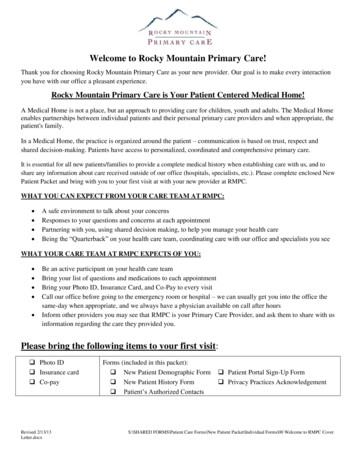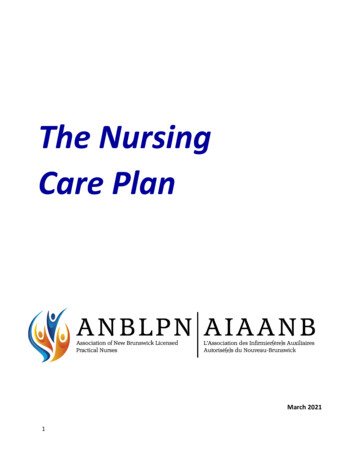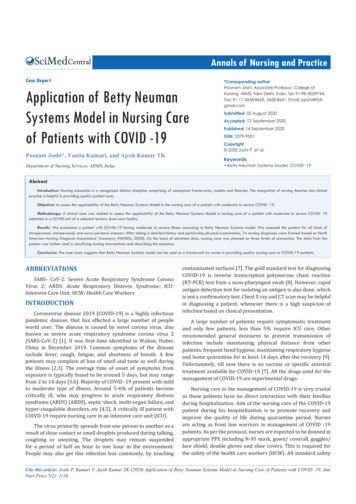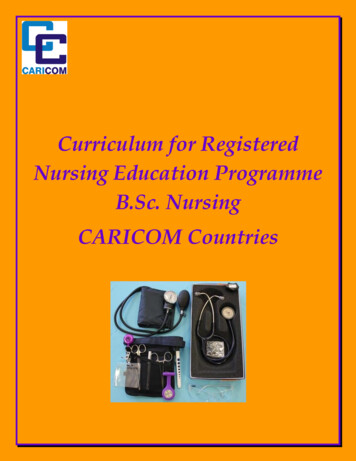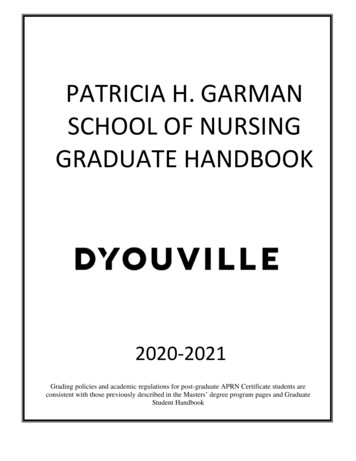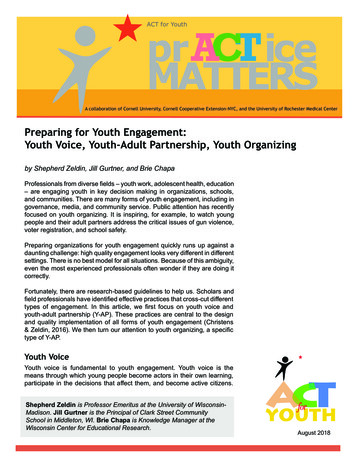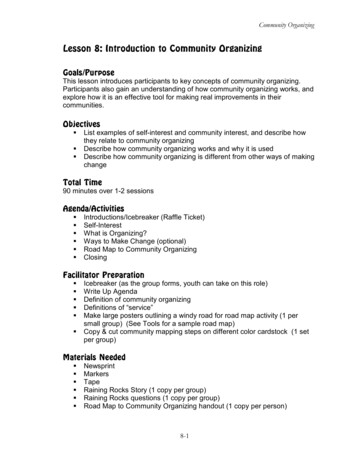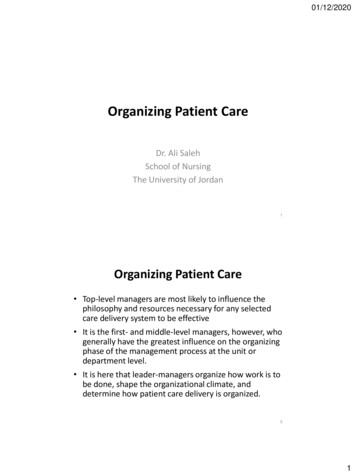
Transcription
01/12/2020Organizing Patient CareDr. Ali SalehSchool of NursingThe University of Jordan1Organizing Patient Care Top-level managers are most likely to influence thephilosophy and resources necessary for any selectedcare delivery system to be effective It is the first- and middle-level managers, however, whogenerally have the greatest influence on the organizingphase of the management process at the unit ordepartment level. It is here that leader-managers organize how work is tobe done, shape the organizational climate, anddetermine how patient care delivery is organized.21
01/12/2020Traditional Modes of Organizing PatientCare Models:–––––Total patient careFunctional nursingTeam and modular nursingPrimary nursingCase management The choice of an organization model involves:–––––Skill and expertise of the staffAvailability of registered professional nursesEconomic resources of the organizationAcuity of the patientsNature of the work /complexity of the tasks to be completed3Total Patient Care Nursing or Case MethodNursing Oldest mode Nurses assume total responsibility during theirtime on duty for meeting all the needs ofassigned patients. Total patient care nursing is sometimes referredto as the case method of assignment At the turn of the 19th century, total patient carewas the predominant nursing care deliverymodel. Care was generally provided in thepatient’s home42
01/12/2020Total Patient Care Nursing or CaseMethod Nursing During the Great Depression of the 1930s,however, people could no longer afford homecare and began using hospitals for care that hadbeen performed by private duty nurses in thehome. During that time, nurses and studentswere the caregivers in hospitals and in publichealth agencies During the 1930s and 1940s, providing total carecontinued to be the primary means of organizingpatient care.563
01/12/2020Total Patient Care Nursing or Case MethodNursingAdvantages: Provides nurses with high autonomy andresponsibility Assigning patients is simple and direct and does notrequire much of planning The lines of responsibility and accountability areclear The patient theoretically receives holistic andunfragmented care during the nurse’s time on duty.7Total Patient Care Nursing or Case MethodNursingDisadvantages: The patient could receive three different approaches tocare, often resulting in confusion for the patient Requires highly skilled personnel and thus may cost morethan some other forms of patient care. Some tasks performed by the primary caregiver could beaccomplished by someone with less training andtherefore at a lower cost When the nurse is inadequately prepared or tooinexperienced to provide total care to the patient Could result in unsafe care because of heavy patient loador little opportunity for supervision84
01/12/2020Functional Nursing Personnel were assigned to complete certain tasks ratherthan care for specific patients e.g. checking BP,medication. A result of World War II and the rapid construction ofhospitals as a result of the Hill Burton Act. However, the baby boom (is a period marked by asignificant increase of birth rate) and resulting populationgrowth immediately following World War II left thecountry short of nurses The use of unlicensed assistive personnel (UAP), alsoknown as nursing assistive personnel RNs became managers of care rather than direct careproviders, and “care through others” became the phraseused to refer to this method of nursing care9105
01/12/2020Functional NursingAdvantages: Economical and efficient means of providingcare Tasks are completed quickly with littleconfusion regarding responsibilities Allow care to be provided with a minimalnumber of RNs such as in the operating room.11Functional NursingDisadvantages May lead to fragmented care and the possibility ofoverlooking patient priority needs Some workers feel unchallenged andunderstimulated in their roles, result in low jobsatisfaction May also not be cost-effective due to the need formany coordinators. Staff focus only on their own efforts, with lessinterest in overall results126
01/12/2020Team Nursing In the 1950s, many believed that a patient caresystem had to be developed that reduced thefragmented care that accompanied functionalnursing. Team nursing was the result. In team nursing, ancillary personnel collaborate inproviding care to a group of patients under thedirection of a professional nurse.13Team Nursing Team leader is responsible for––––––Knowing the condition and needs of all the patientsPlanning individual careAssisting team membersGiving direct personal care to patientsTeachingCoordinating patient activities Communication:– Informally– Formally (team planning conferences) Not more than 5 staff147
01/12/202015Team NursingAdvantages Usually associated with democraticleadership.– Member autonomy– Team shares responsibility and accountabilitycollectively Members contribute their own specialexpertise or skills Results in high job satisfaction168
01/12/2020Team NursingDisadvantages Need for excellent communication and coordinationskills Requires great self-discipline on the part of teammembers Insufficient time for planning and communication– Blurred lines of responsibility– Errors– Fragmented patient care The team leader must be an excellent practitionerand have good communication, organizational,management, and leadership skills17Most team nursing was never practiced in itspurest form but was instead a combination ofteam and functional structure.189
01/12/2020The Multidisciplinary Team Leader Role Expanding the opportunities for nurses to lead anddiffuse collaborative improvement efforts withphysicians and other members of the health-careteam to improve practice environments.19The Multidisciplinary Team Leader RoleImplementation problems: Having experts on teams is different than having expert teams Each discipline may believe that their perspective is mostimportant and undervalue the contributions of other teammembers. Require an efficient means of communication about patientgoals, progress, and problems. It is not often easy to find opportunities for the whole team tomeet because of work shift patterns or other workcommitments. Challenges in determining who the members of the teamshould be and who should be the leader of the team.2010
01/12/2020Modular Nursing Modular nursing uses a mini-team (two or threemembers with at least one member being an RN) Sometimes being called care pairs. In modular nursing, patient care units are typicallydivided into modules or districts, and assignments arebased on the geographical location of patients. Allow the professional nurse more time for planning andcoordinating team members. Requires less communication, allowing members betteruse of their time for direct patient care activities.21Primary Nursing (relationship-basednursing) Was developed in the late 1960s, uses some of theconcepts of total patient care and brings the RN back to thebedside to provide clinical care The primary nurse assumes 24-hour responsibility forplanning the care of one or more patients from admissionor the start of treatment to discharge or the treatment’send. During work hours, the primary nurse provides total directcare for the patient. Associate nurses who follow the care plan established bythe primary nurse, provide care. e.g. home health nursing, hospice nursing2211
01/12/202023Primary Nursing Primary nurse establish clear communicationamong the pt, physician, associate nurses, otherteam members.Advantages Clear interdisciplinary communication andconsistent patient care by relatively few nursingstaff allows for:– Holistic– high-quality patient care High job satisfaction Often feel challenged and rewarded2412
01/12/2020Primary NursingDisadvantages Difficult to implement because of the degreeof responsibility and autonomy required ofthe primary nurse. Improper implementation Nurses may be uncomfortable in this role orinitially lack the experience and skillsnecessary for the role Difficult to recruit and retain enough RNs25Case Management Case management is defined as acollaborative process of assessment, planning,facilitation, and advocacy for options andservices to meet an individual’s health needsthrough communication and availableresources to promote quality cost-effectiveoutcomes” (CMSA, 2016)2613
01/12/2020Case Management Case managers handle each case individually, identifyingthe most cost-effective providers, treatments, and caresettings possible. Case manager helps patients access communityresources, helps patients learn about their medicationregimen and treatment plan, and ensures that they haverecommended tests and procedures. Acute care case management may be:––––Unit basedAssigned by patientDisease basedPrimary nurse case managed27Case Management Case managers often manage care using critical pathways andmultidisciplinary action plans (MAPs) to plan patient care. The care MAP is a combination of a critical pathway and anursing care plan. MAP indicates times when nursing interventions should occur. All health-care providers follow the care MAP to facilitateexpected outcomes. If a patient deviates from the normal plan, a variance isindicated. A variance is anything that occurs to alter thepatient’s progress through the normal critical path.2814
01/12/2020Disease Management Programs Also known as population-based health care and continuoushealth improvement. Provide a comprehensive, integrated approach to the careand reimbursement of common, high-cost, chronic illnesses. Focus on prevention as well as early disease detection andintervention to avoid costly acute episodes, but providescomprehensive care and reimbursement. Target population groups (population based) rather thanindividuals.29Disease Management Programs Employ a multidisciplinary healthcare team, includingspecialists. Use standardized clinical guidelines–clinical pathwaysreflecting best practice research to guide providers. Use integrated data management systems to track patientprogress across care settings and allow continuous andongoing improvement of treatment algorithms. Frequently employ professional nurses in the role of casemanager or program coordinator3015
01/12/2020Integrating Leadership Roles and ManagementFunctions in Organizing Patient Care Selecting and implementing a patient care deliverysystem that facilitates the accomplishment of unit goals,reduces costs and improves patient outcomes The emphasis is on seeking solutions to poororganization of work rather than finding fault. Ensures that the type of patient care delivery modelselected will provide quality care and staff satisfaction. Ensures that change in the mode of delivery will not beattempted without adequate resources, appropriatejustification, and attention to how it will affect groupcohesiveness3116
Case managers often manage care using critical pathways and multidisciplinary action plans (MAPs) to plan patient care. The care MAP is a combination of a critical pathway and a nursing care plan. MAP indicates times when nursing interventions should occur. All health-care providers follow the care MAP to facilitate expected .

